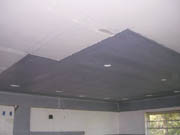
A meeting of old and new
Photo #1 gives you the scoop, score and the skinny on what needed to be tackled. It involved areas that were full coat plastered and left in place and some sections where this was taken out and 5/8-inch plaster board was installed on the ceiling area and 1/2 inch on the walls. This type of "old and new" project presents unique challenges.
A new project with all plaster board skimmed out with two coats of base and finish and the project is done. Resurfacing over walls and ceilings of existing plaster at least gives a consistent base over which one's basecoating and finishing. With this one, it's a little of this, a little of that and so it took a little more to bring it all together.
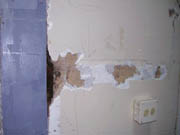
The gap thing
Photo #2 shows one of several areas that give plasterers fits-a wide-open gap where the new board and the old plaster just don't come together quite right. Now, I don't mind gaps of 1/4 inch or so but when it gets to be 1 inch or wider, the plaster that is pushed into such an area is going to slip through and it's nearly impossible to get any kind of firm base in areas like this.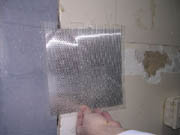
When I do training of individuals who really want to learn this trade, one thing I emphasize from the start is to look the project over well before giving a bid. Contractors often have to be trained to get things right and ready for the plastering work that comes after them. For instance, when soffits are taken down in kitchens or walls are removed, there are often edges of old paint and plaster left behind that outline all the areas that were removed; or it might be chicken wire or metal lath that was cut and the ragged edges are all hanging through and need to be dealt with before any plastering can be done. Add to this the stabilizing and securing of the areas (loose board, nails and screws left out about 1/4 inch or so, and you start to get the picture).
I remember one project where it took me almost half a day to get the surfaces ready for plaster. Often, when a contractor or homeowner is looking at these areas, they are completely oblivious to the amount of work that these small details require. So, I try to educate the contractors I work with, helping them to understand clearly what I want the job to look like when I get there. This is a much more positive approach then arriving on the job and getting mad because of some surprises. Sometimes, those who do this type of work are so familiar with it, expectations are set too high on what the contractor is supposed to know and not enough communicating is done to ensure that the areas needing to be put back together are prepped and in a ready-to-plaster condition. Walking them through it a few times goes a long way in making sure the job goes smoothly.
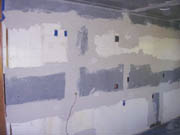
Bond and beyond
The next step is to bond the walls and ceilings with a latex bonder. Maybe I'm overly cautious but I like to double bond the surfaces-running a coat of bonder over the existing plaster, then doubling back and coating it again. It builds up the bonding agent and ensures that the existing plaster is going to form a good strong bond to the new plaster being applied. I've been receiving too many letters and e-mails lately from people who have had nightmares, all because the plaster was delaminating from the walls or ceilings. Simply put: The wrong type of bonder was used, or not enough was used. This is too critical a step to slough off on. It's got to be done right and taking the time to do it properly pays in the long run.
After bonding, I get some fans going and dry the surfaces thoroughly. Now, I'm ready for the next step, embedding the fiberglass mesh in areas where the old meets the new. You can see how it's done in photos #4 and #5. I mix up a batch and work on all the areas where old meets new. I keep it tight. In other words, I don't build up the basecoat in a thick layer. My main goal is to embed the heavy fiberglass mesh into the basecoat-bridging the gap between the two surfaces.
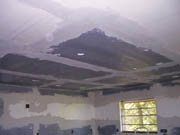
Quality all the way
Now here is one more point: Notice that there's a lot of wall space I'm doing in photo #4. Most of this area is going to be covered in cabinets. But I approach it as if it all was going to show. The reason is simple: If I start skimping and trying to figure where I can get away with doing a cruder job, that's the time I should hang up my trowel. It's interesting and almost amusing at times when a contractor or more often a homeowner will take me through the room and draw these invisible lines, basically saying, "Now here you can do a little less of a job but in these spots here-and-here it's going to show, so make sure it looks great here." I'm not into that. And I encourage readers to do the best in all areas and resist the temptation to divide the type of work you do into "good," "good enough" or "close." It will come back to haunt you.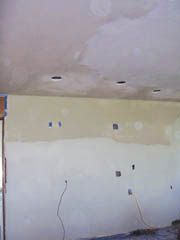
The challenge that this type of project poses is the difference in the absorption rate between the boarded areas and the existing plaster. To even it out, I waited until the next day to finish coat the surfaces. I used a pump sprayer and wet the ceiling and wall areas down just before smooth coating them. This gave me a nice even surface to finish out.
I also wanted to let you know we're still running the Plaster Man/Walls & Ceilings T-shirt giveaway. Simply send your name and address via e-mail to robin@plasterzone.com or send it by mail to this magazine. Congratulations go out to this month's winner Dan Griffin, of Oklahoma.
Until next time, Plaster On!


